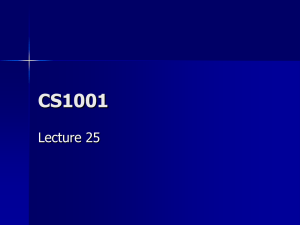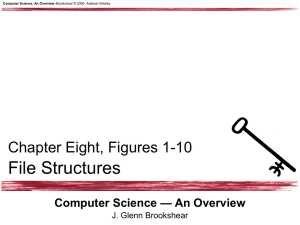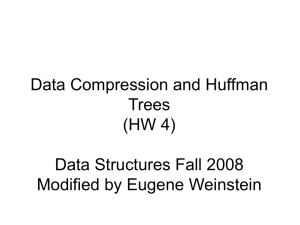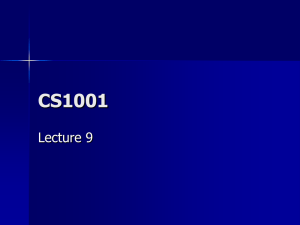CMSC 100 – Fall 2008 Homework #2 Handed out Thursday, 9/11/08
advertisement
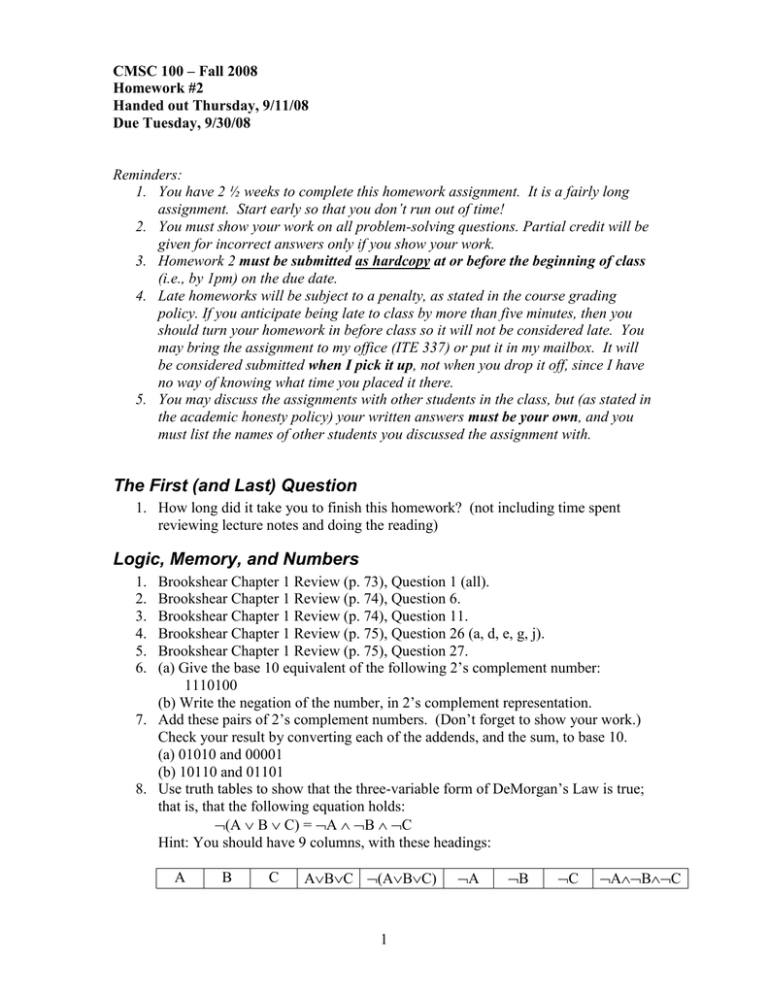
CMSC 100 – Fall 2008 Homework #2 Handed out Thursday, 9/11/08 Due Tuesday, 9/30/08 Reminders: 1. You have 2 ½ weeks to complete this homework assignment. It is a fairly long assignment. Start early so that you don’t run out of time! 2. You must show your work on all problem-solving questions. Partial credit will be given for incorrect answers only if you show your work. 3. Homework 2 must be submitted as hardcopy at or before the beginning of class (i.e., by 1pm) on the due date. 4. Late homeworks will be subject to a penalty, as stated in the course grading policy. If you anticipate being late to class by more than five minutes, then you should turn your homework in before class so it will not be considered late. You may bring the assignment to my office (ITE 337) or put it in my mailbox. It will be considered submitted when I pick it up, not when you drop it off, since I have no way of knowing what time you placed it there. 5. You may discuss the assignments with other students in the class, but (as stated in the academic honesty policy) your written answers must be your own, and you must list the names of other students you discussed the assignment with. The First (and Last) Question 1. How long did it take you to finish this homework? (not including time spent reviewing lecture notes and doing the reading) Logic, Memory, and Numbers 1. 2. 3. 4. 5. 6. Brookshear Chapter 1 Review (p. 73), Question 1 (all). Brookshear Chapter 1 Review (p. 74), Question 6. Brookshear Chapter 1 Review (p. 74), Question 11. Brookshear Chapter 1 Review (p. 75), Question 26 (a, d, e, g, j). Brookshear Chapter 1 Review (p. 75), Question 27. (a) Give the base 10 equivalent of the following 2’s complement number: 1110100 (b) Write the negation of the number, in 2’s complement representation. 7. Add these pairs of 2’s complement numbers. (Don’t forget to show your work.) Check your result by converting each of the addends, and the sum, to base 10. (a) 01010 and 00001 (b) 10110 and 01101 8. Use truth tables to show that the three-variable form of DeMorgan’s Law is true; that is, that the following equation holds: (A B C) = A B C Hint: You should have 9 columns, with these headings: A B C ABC (ABC) 1 A B C ABC 9. Show circuits (logic gates) that are equivalent to each of these expressions: (a) (A B) (B C) (b) (A B) (B C) (C A) EXTRA CREDIT: Simplify the expression in (b) to give an equivalent expression that contains only two terms. (Hint: each term will include all three variables in some logical combination.) Encoding Data 1. What is the difference between lossless and lossy encoding? Give two examples of each type (lossless and lossy). Briefly discuss what makes each method lossless or lossy, and why this is an appropriate choice for the type of data being encoded. 2. Here is a message: the cat in the hat came back. (a) Give a frequency table, listing the frequency (number of occurrence) of the letters in the message. (Don’t forget spaces and the period at the end!) (b) Construct a Huffman code and show the resulting tree. (Like the examples we did in class, you should show the letters and frequencies at the leaf nodes, and the accumulated frequencies at the internal nodes.) (c) Write out the encoded message string in binary representation. (Please leave spaces between the encoding of each letter to increase the readability of your answer.) (d) How many bits does it take to encode the message using an ASCII representation? (e) How many bits does it take to encode the message using the Huffman code you constructed? (f) What compression rate did the Huffman encoding give you? Algorithms 1. Which of these is not a characteristic of an algorithm? (a) It must terminate. (b) The steps must be unambiguous. (c) The steps must be executed in the order in which they are written. (d) The algorithm may have one or more variables. 2. What does this pseudocode compute? (I’m looking for a simple English description, not a mathematical expression.) Total 0 Number 0 while ( items remaining in List ) do ( Total Total + next item Number Number + 1 go to next item in List ) X = Total / Number 2 3. Brookshear Chapter 5 Review Questions (p. 255), Question 21. 4. Brookshear Chapter 5 Review Questions (p. 257), Question 43. 5. Extra credit: In English, explain what this pseudocode computes: List Sort(List) Item List[1] for i from 1 to Length(List) do ( if ( List [i] Item ) do ( Item = List[i] N N + 1 ) ) print(N) Finite State Machines 1. Draw a finite state machine that recognizes a sequence of coin tosses that is either all heads or all tails. Label each state as “S” (success) or “F” (failure). 3
